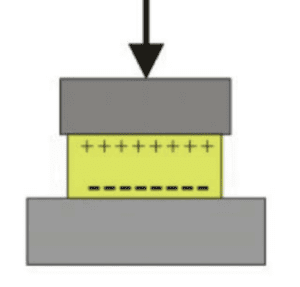Servo Accelerometer
Servo accelerometers kaise kaam karte hain, yeh samajhne ke liye unke basic principle aur components ko dekhte hain. Yeh high-precision sensors hote hain jo acceleration, tilt, ya vibration measure karte hain. Inka kaam closed-loop feedback system pe based hota hai, jo inhe bohot accurate banata hai. Chalo, step-by-step samjhte hain:
Main Parts
- Proof Mass: Ek chhota sa mass jo spring ya flexure pe latka hota hai.
- Position Sensor: Yeh proof mass ke movement ko detect karta hai (jaise capacitive ya electromagnetic sensor).
- Force Generator (Servo): Yeh proof mass ko wapas uski original position pe laane ke liye force lagata hai (usually electromagnetic ya electrostatic).
- Feedback Circuit: Sensor se signal leke force generator ko control karta hai.
Kaise Kaam Karta Hai?
- Acceleration Input: Jab accelerometer ko acceleration milta hai (jaise motion ya gravity se), proof mass apni inertia ki wajah se hilne lagta hai.
- Displacement Detect: Position sensor proof mass ke is movement ko pakadta hai.
- Feedback Loop: Feedback circuit is displacement ko analyze karta hai aur force generator ko signal bhejta hai.
- Restoring Force: Force generator ek force lagata hai jo proof mass ko wapas uski neutral position pe le aata hai. Yeh force acceleration ke proportional hota hai.
- Output: Jo force (ya current/voltage) proof mass ko rokne ke liye lagayi jati hai, usse measure karke acceleration ka output milta hai.
Benefits
- Accuracy: Closed-loop system se errors kam hote hain, result bohot precise milta hai.
- Wide Range: Chhoti ya badi acceleration dono measure kar sakta hai.
- Low Noise: Feedback se noise aur drift kam hota hai.
- Linear Output: Output acceleration ke saath straight line mein hota hai.
Uses
- Aerospace (navigation, flight control)
- Seismic monitoring (earthquake detection)
- Industrial (vibration check, machine monitoring)
- Automotive (crash testing, stability)
Example
Ek capacitive servo accelerometer mein, jab proof mass hilta hai, toh plates ke beech capacitance change hoti hai. Feedback circuit is change ko dekhta hai aur electrostatic force lagata hai mass ko wapas laane ke liye. Is force ke liye jo current use hota hai, woh acceleration ke barabar hota hai aur output deta hai.
Piezoelectric Accelerometer

- Piezo-electric crystals are man-made or naturally occurring crystals that produce a charge output when they are compressed, flexed or subjected to shear forces.
- In a piezo-electric accelerometer a mass is attached to a piezo-electric crystal, which is in turn mounted to the case of the accelerometer.
- When the body of the accelerometer is subjected to vibration the mass mounted on the crystal wants to stay still in space due to inertia and so compresses and stretches the piezo electric crystal.
- This force causes a charge to be generated and due to Newton law F=ma this force is in turn proportional to acceleration.
- The charge output is either is converted to a low impedance voltage output by the use of integral electronics or made available as a charge output (Pico-coulombs /g) in a charge output piezo-electric accelerometer.
Hinglish mein :
Piezo accelerometers bhi acceleration, vibration, ya shock measure karne ke liye use hote hain, lekin yeh servo accelerometers se thoda alag tareeke se kaam karte hain. Inka basic principle piezoelectric effect pe based hota hai. Chalo, Hinglish mein step-by-step samajhte hain:
Main Parts
- Piezoelectric Material: Yeh ek special material hota hai (jaise quartz ya ceramic) jo pressure ya force lagane pe electric charge generate karta hai.
- Proof Mass: Ek chhota sa mass jo piezoelectric material ke saath connected hota hai.
- Housing: Yeh pura setup ek strong case mein hota hai jo external vibrations ko handle karta hai.
- Electrodes: Piezo material se electric charge collect karne ke liye.
Kaise Kaam Karta Hai?
- Acceleration Input: Jab accelerometer ko acceleration milta hai (jaise vibration ya motion), proof mass move karta hai.
- Force on Piezo Material: Proof mass ka movement piezoelectric material pe pressure ya force daalta hai.
- Piezoelectric Effect: Is pressure ki wajah se piezo material electric charge generate karta hai. Yeh charge acceleration ke proportional hota hai.
- Signal Output: Electrodes is electric charge ko collect karte hain, aur yeh charge voltage signal mein convert hota hai. Yeh voltage hi accelerometer ka output hota hai, jo acceleration ko represent karta hai.
- Amplification (Optional): Kai baar signal ko amplify karne ke liye built-in electronics use hoti hain, taaki output clear aur strong ho.
Features
- Simple Design: Inmein servo jaisa complex feedback system nahi hota, isliye yeh compact aur lightweight hote hain.
- High Frequency Range: Vibrations ya fast movements measure karne mein yeh bohot ache hote hain.
- Rugged: Yeh tough conditions (high temperature, shock) mein bhi kaam kar sakte hain.
- No Power Supply (Sometimes): Basic piezo accelerometers ko external power ki zarurat nahi hoti, lekin amplified models mein hoti hai.
Limitations
- Low Frequency Issue: Boht slow movements ya static acceleration (jaise gravity) measure karne mein yeh utne ache nahi hote.
- Output Drift: Time ke saath signal mein thodi inconsistency aa sakti hai.
Uses
- Industrial (machine vibration monitoring, motor testing)
- Automotive (crash testing, engine analysis)
- Aerospace (structural testing)
- Consumer Electronics (gaming controllers, smartphone vibration detection)
Example
Ek typical piezo accelerometer mein, jab ek machine vibrate karti hai, proof mass piezo crystal pe force daalta hai. Crystal is force se electric charge banata hai, jo electrodes ke through voltage signal ke roop mein bahar aata hai. Yeh signal analyze karke vibration ki intensity aur frequency pata chalti hai.